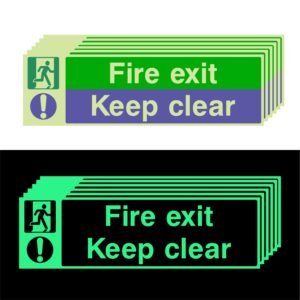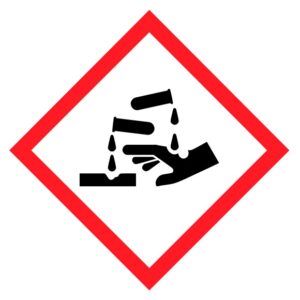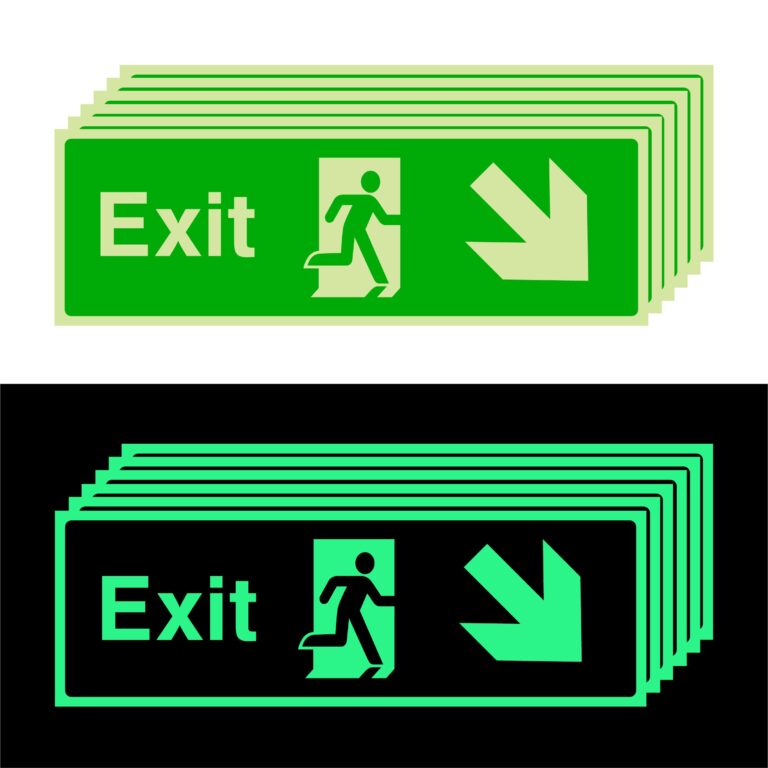Emergencies can happen unexpectedly, and when they do, every second counts. In situations where power may fail, visibility becomes crucial for ensuring a quick and safe evacuation. Photoluminescent signs, with their ability to glow in the dark after absorbing light, are a game-changer when it comes to guiding people to safety. These signs serve as a reliable and effective means of providing direction in low-light or smoky environments, making them indispensable in many safety-critical areas.
What Are Photoluminescent Signs?
Photoluminescent signs are safety indicators made from materials that absorb light during the day and emit that light when it gets dark. These signs do not require an external power source and can glow for hours after being exposed to light. They are commonly used in environments where safety needs to be maintained even when the electricity goes out, such as in buildings, industrial sites, transport hubs, and more.
Some common applications for photoluminescent signs include photoluminescent fire exit signs, emergency lighting, and directional indicators for evacuations. They can be designed in various forms, from simple exit signs to more complex directional signs indicating fire extinguisher locations, emergency exits, or escape routes.
The Benefits of Photoluminescent Signs in Emergency Situations
In emergency situations, the ability to quickly locate an exit or safety equipment is crucial. Photoluminescent signs offer a wide range of benefits, making them a preferred choice for many businesses and organisations. Here are some of the primary advantages:
- Enhanced Visibility in Low Light: Photoluminescent signs are highly effective in dark or smoky environments. During power outages or when visibility is reduced due to smoke or fire, these signs will continue to shine, guiding people safely to exits and emergency zones.
- Energy Independence: One of the main benefits of photoluminescent signs is that they do not rely on electricity to function. As long as they have been exposed to light, they will continue to glow for an extended period, ensuring that they are functional even during a power failure.
- Cost-Effective and Eco-Friendly: Photoluminescent signs are a sustainable choice. They require no batteries or electricity, which reduces long-term energy costs and environmental impact. These signs are also made from recyclable materials, contributing to their eco-friendliness.
- Durability: Photoluminescent signs are built to last. These signs are resistant to the elements and can withstand extreme temperatures, humidity, and wear and tear, making them suitable for use in a variety of environments, from industrial settings to office buildings.
- Non-Toxic and Safe: Unlike some illuminated signs that rely on chemicals or hazardous materials, photoluminescent signs are non-toxic. They are a safer choice, particularly in environments where safety is of the utmost importance, such as hospitals, schools, and public buildings.

Key Applications of Photoluminescent Signs
Photoluminescent signs are used in a variety of settings to ensure safe evacuations and quick access to emergency equipment. Here are some key applications:
- Fire Safety: One of the most common uses of photoluminescent signs is to mark fire exits, extinguishers, and emergency escape routes. Photoluminescent fire exit signs are placed along evacuation routes and at emergency exits, ensuring that they remain visible during power failures or smoke-filled environments.
- Public Spaces: In places like theatres, shopping malls, and airports, photoluminescent signs direct people to safety zones during emergencies. These signs are easy to spot and help people find the nearest exit, which is especially important in crowded environments where panic can cause confusion.
- Industrial Settings: In warehouses, factories, and construction sites, photoluminescent signs mark fire hazards, escape routes, and emergency equipment locations.
- Transport: Airports, train stations, and ships often use photoluminescent signs to guide passengers during emergencies, especially in situations where lighting systems fail.
Regulations and Standards for Photoluminescent Signage
When it comes to safety, compliance with regulations is essential. Photoluminescent signs must meet certain standards to ensure that they perform effectively in an emergency.
In addition to fire safety regulations, photoluminescent signs should be compliant with local building codes and international fire safety standards. Certification is crucial to ensure that the signs meet the required safety criteria.
How to Choose the Right Photoluminescent Signs
Choosing the right photoluminescent signs for your building or facility is essential to ensure that they perform effectively when needed most. Here are a few factors to consider:
- Visibility and Placement: The signs should be installed in high-traffic areas, such as hallways, stairwells, and near fire exits. Ensure that they are visible from a distance and placed in locations where people will be able to see them in low-light conditions.
- Size and Design: The size and design of the signs should align with their intended purpose. Larger signs may be needed in areas with high foot traffic, while smaller, more discreet signs may be suitable for less busy spaces.
- Durability and Material: Ensure that the photoluminescent signs you choose are made from durable materials that can withstand wear and tear.
- Compliance: Make sure that the signs you choose comply with local regulations and safety standards. Always choose signs that are certified and meet fire safety requirements.

Maintenance and Care for Photoluminescent Signs
One of the significant advantages of photoluminescent signs is that they require very little maintenance. However, regular upkeep will ensure that they remain effective for years, including proper care of elements like the corrosion safety symbol to maintain their visibility and durability. Here are some tips for maintaining photoluminescent signs:
- Cleaning: Dust and dirt can reduce the brightness of photoluminescent materials. Clean the signs regularly with a soft cloth and mild soap to keep them bright and visible.
- Inspection: Check the signs periodically for any damage or wear, especially in high-traffic areas. If the sign is cracked or significantly faded, it should be replaced.
- Replace Worn Signs: Over time, the glow from photoluminescent signs may diminish. Replace signs that no longer provide sufficient visibility, ensuring that safety is always a top priority.
Conclusion
Photoluminescent signs are a vital part of any emergency preparedness plan. Their ability to glow in the dark without requiring an external power source makes them a reliable and cost-effective solution for ensuring safety in emergency situations. Whether used in commercial buildings, industrial settings, or transport hubs, photoluminescent fire exit signs and other safety indicators can significantly improve evacuation times and provide clear guidance when it’s needed most. At Foamex Printing Company, we offer a wide range of high-quality photoluminescent signs that meet all safety standards.
